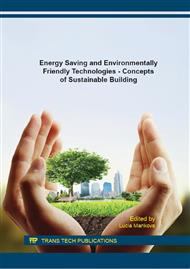p.707
p.715
p.724
p.732
p.740
p.751
p.761
p.770
p.779
Implementation of Simulation-Based Virtual Sensors Using Radiance and Java
Abstract:
Building performance simulation is traditionally used to support the building design process. However, it can also be used during building operation phase by providing relevant data to building automation systems. We refer to monitoring and metering data generated by computational simulation (virtual) models as data from virtual sensors. Virtual sensors, if reliably and effectively incorporated, can expand the reach of real sensors. A continuous supply of virtual sensor data can support near real-time representation of both primary environmental variables (e.g., air temperature, relative humidity) as well as complex performance indicators (e.g., thermal comfort indices, visual glare). Such information, especially in large multi-zone buildings, would be otherwise expensive to obtain from real sensors due to high capital costs of the sensors, their installation, networking, and maintenance. Virtual sensors can increase the resolution of sensory information, as they imply little monetary expenditures and are not limited in view of numbers and location.Conventional building energy simulation uses a model of the building and creates boundary conditions using historic weather data and predefined schedules for lighting and equipment load. This method is suitable for evaluation of building designs but not suitable for monitoring and control processes during building operation phase, as such processes usually require actual real-time information regarding boundary conditions. Thus, capability to automatically update simulation model's boundary conditions in real-time using monitored data is required. Toward this end, a supervisory software application is developed, in Java programming language, to implement and illustrate the concept of virtual sensors using Radiance simulation program. This application creates virtual illuminance sensors in Radiance model and then automates the process of regularly updating simulation model's external and internal boundary conditions (solar irradiance, state of electrical lighting elements) by using real-time monitored data from on-site weather station and building management system (BMS). As a result, the simulation kernel can continuously generate virtual sensor readings that can be utilized by building monitoring and/or control systems. This paper discusses the general architecture of the application, to further illustrate the concept of virtual sensors. Moreover, it discusses the accuracy of virtual illuminance sensors by comparing their output with monitored illuminance data in realistic test scenarios.
Info:
Periodical:
Pages:
740-747
Citation:
Online since:
January 2016
Authors:
Keywords:
Price:
Сopyright:
© 2016 Trans Tech Publications Ltd. All Rights Reserved
Share:
Citation:


